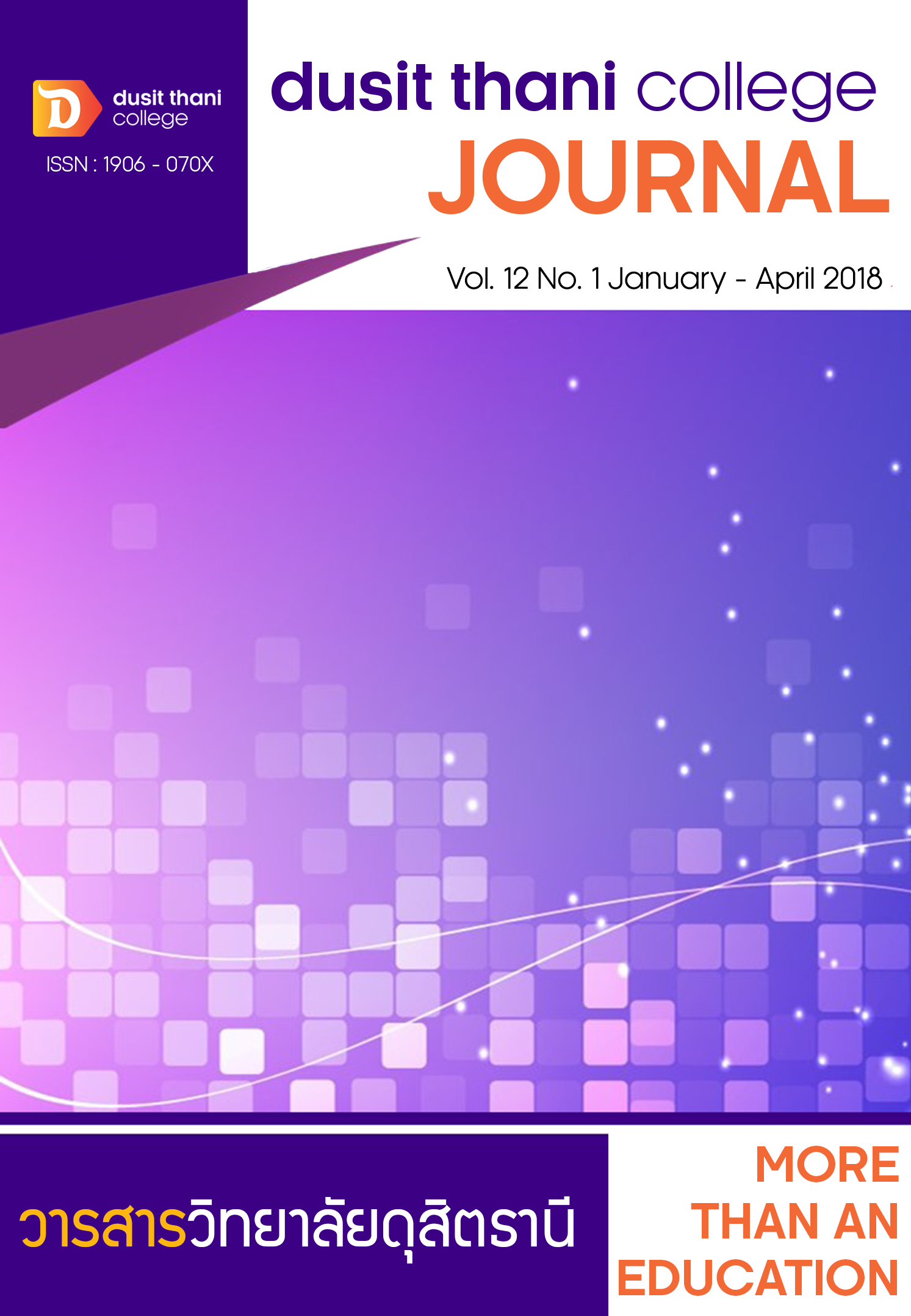การพัฒนาโปรแกรมเสริมสร้างแรงผลักดันทางการบริหารเชิงสร้างสรรค์ เพื่อมุ่งสู่วิธีการจัดการความปลอดภัย และอาชีวอนามัยในธุรกิจโรงแรม
Main Article Content
บทคัดย่อ
The purposes of this study were to design the components of the creative management program, to develop the model and to develop the standard manual to enhance creative management toward occupational health and safety management in hotel business. The research methodology was the integration of mixed methodology between the quantitative research and qualitative research. The population was the management level employees from 5 Stars hotel. The purposive sampling of 280 samples was from management level employees. The key informants were eight top management level employees for focus group and evaluation of the construct validity of the developed standard manual by using the Multitrait-Multimethod Matrix (MTMM). The Confirmatory Factor Analysis (CFA) of the questionnaires found that there were 7 creative components, including Vision, Imagination, Process Improvement, Motivation, Collaboration, Flexibility and Invention, or “VIP-MCFI” Model, which was confirmed to develop the standard manual for developing hotel’s leaders toward creative management by following the components of the occupational health and safety management.
Article Details
นโยบายการพิจารณากลั่นกรองบทความ
- บทความวิจัยและบทความวิชาการทุกเรื่องที่จะได้รับการตีพิมพ์ต้องผ่านการพิจารณากลั่นกรองโดยผู้ทรงคุณวุฒิ (Peer Review) ในสาขาที่เกี่ยวข้อง จำนวน 3 ท่าน/บทความ
- บทความ ข้อความ ภาพประกอบและตารางประกอบที่ลงตีพิมพ์ในวารสารเป็นความคิดเห็นส่วนตัวของผู้เขียน กองบรรณาธิการไม่จำเป็นต้องเห็นด้วยเสมอไป และไม่มีส่วนรับผิดชอบใด ๆ ถือเป็นความรับผิดชอบของผู้เขียนแต่เพียงผู้เดียว
- บทความที่จะได้รับการตีพิมพ์จะต้องไม่เคยตีพิมพ์ เผยแพร่ที่ใดมาก่อน และไม่อยู่ระหว่างการพิจารณาของวารสารฉบับอื่น หากตรวจสอบพบว่ามีการตีพิมพ์ซ้ำซ้อน ถือเป็นความรับผิดชอบของผู้เขียนแต่เพียงผู้เดียว
- บทความใดที่ผู้อ่านเห็นว่าได้มีการลอกเลียนหรือแอบอ้างโดยปราศจากการอ้างอิง หรือทำให้เข้าใจผิดว่าเป็นผลงานของผู้เขียน กรุณาแจ้งให้กองบรรณาธิการวารสารทราบจะเป็นพระคุณยิ่ง
เอกสารอ้างอิง
ASEAN OSHNET CBM. (2007). Plan of Action on National Occupational Safety and Health Framework for ASEAN. Singapore: ASEAN OSHNET CBM.
Bureau of Safety. (2015). Situation of Thailand Safety and Occupational Health Performance year 2015. Bangkok, Department of Welfare and Labor Protection, Ministry of Labor. Bangkok.
Bureau of Labor Safety. (2014). National Plan of Safety Occupational Health and Working Environment (2012-2016). Department of Welfare and Labor Protection, Ministry of Labor. Bangkok: Partnership Limited Bangkok Block.
Department of Tourism. (2014). Standard of accommodation for tourism – Hotel, 5 Stars, Revision1 Standard Code Mo-To-To 202, Volume 21: 2014. Ministry of Tourism and Sports. Bangkok.
Department of Welfare and Labor Protection. (2015). Training Manual Safety Officer at Management Level. Ministry of Labor. Bangkok: Reangsam Graphic Design Co; ltd.
European Agency for Safety and Health at Work. (2012). Management Leadership in Occupational Safety and Health–A practical guide. Luxembourg: Publications Office of the European Union.
Hamel, G. (2012). What matters now: How we win in a world of relentless change,ferocious competition, and unstoppable innovation. San Fransisco: Jossey-Bass.
Health and Safety Executive (HSE). (2001). Non-fatal major injuries reported to all enforcing authorities by industry 1997/98 to 2001/02p. https://www.hse.gov.uk/statistics/pdf/table4.pdf - Accessed 01.07.03.
Heifetz, Grashow, and Linsky. (2009). Leadership in a (Permanent) Crisis. Harvard Business Review.
Hospitality Industry OHS Committee. (2000). Managing Occupational Health and Safety in the Hospitality Industry Small Employers. WorkCover Corporation's Marketing & Communications Department, South Australia.
International Labor Organization. (2009). World Day for Safety and Health at Work 2009 Facts on Safety and Health at Work. International Labour Office. Geneva Switzerland.
International Labor Organization. (2014). Good Practices Guide for Guesthouse and Small Hotel. International Labour Organization Web site: https://www.ilo.org.wcmsps/groups /.../wcms_203969.pdf.
Kelley, T., & Littman, J. (2001). The art of innovation. New York: Doubleday.
Kittanawat Somsak. (2002). A Model Development to Enhance the Creative Leader for Small and Medium Entrepreneurs by Using the Principles of Organizing Activities Based on Humanist and Anthony Robbins’ Self-Empowerment. Bangkok: Chulalongkorn Press.
Morgan, D. L. & Scannell, A. U. (1998). Planning focus group. In D.L. Morgan, R.A. Kruger, and J.A. King, (Eds)., Focus Group Kits, 2. Thousand Oaks, CA: Sage.
Nares Boonchoi, et al. (2012). Strategic Plan for Developing Creative Leader of Educational Leader. Graduate School Jounal, Valaya Alongkorn Rajabhat University under the Royal Patronage, Year 6: Volume 3, September – December 2012.
Patipan Kittkhan. (2012). A Structural Equation Model of Creative Leadership for Vocational College Administrators. Graduate school, Khon Kaen University.
Qun, T. F. & Kawakami, T. (2009). The ASEAN Occupational Safety and Health Network: Good Occupational Safety and Health Practice 2008/2009. Lao PDR: ASEAN Occupational Safety and Health Network.
Rungreung Somchai and Chantuk Thirawat. (2017). Enhancing Factors for Safety, Occupational Health and Working Environment Management in Hotel Business. Graduate Studies Journal. Suan Sunandha Ratjabhat University, Year 10: Volume 1, January-June 2017. Bangkok.
Rungreung Somchai and Chantuk Thirawat. (2017). Model Developing Leader to Enhance Creativity. Veridian E - Journal, Humanities Social Science and Arts, Year 10, Volume 1, January – April 2017, Graduate College. Silpakorn University, Bangkok.
Susan Buchanan, et al. (2010). Occupational Injury Disparities in the US Hotel Industry. American Journal of Industrial Medicine 53:116–125.
Taylor, W. C. (2011). Practically radical: Not-so-crazy ways to transform your company,shake up your industry, and challenge yourself. New York: Harper & Collins.
Workmen’ s Compensation Fund. (2016). Statistic of Work Related Injury and Illness 2011-2015. Ministry of Labor.


